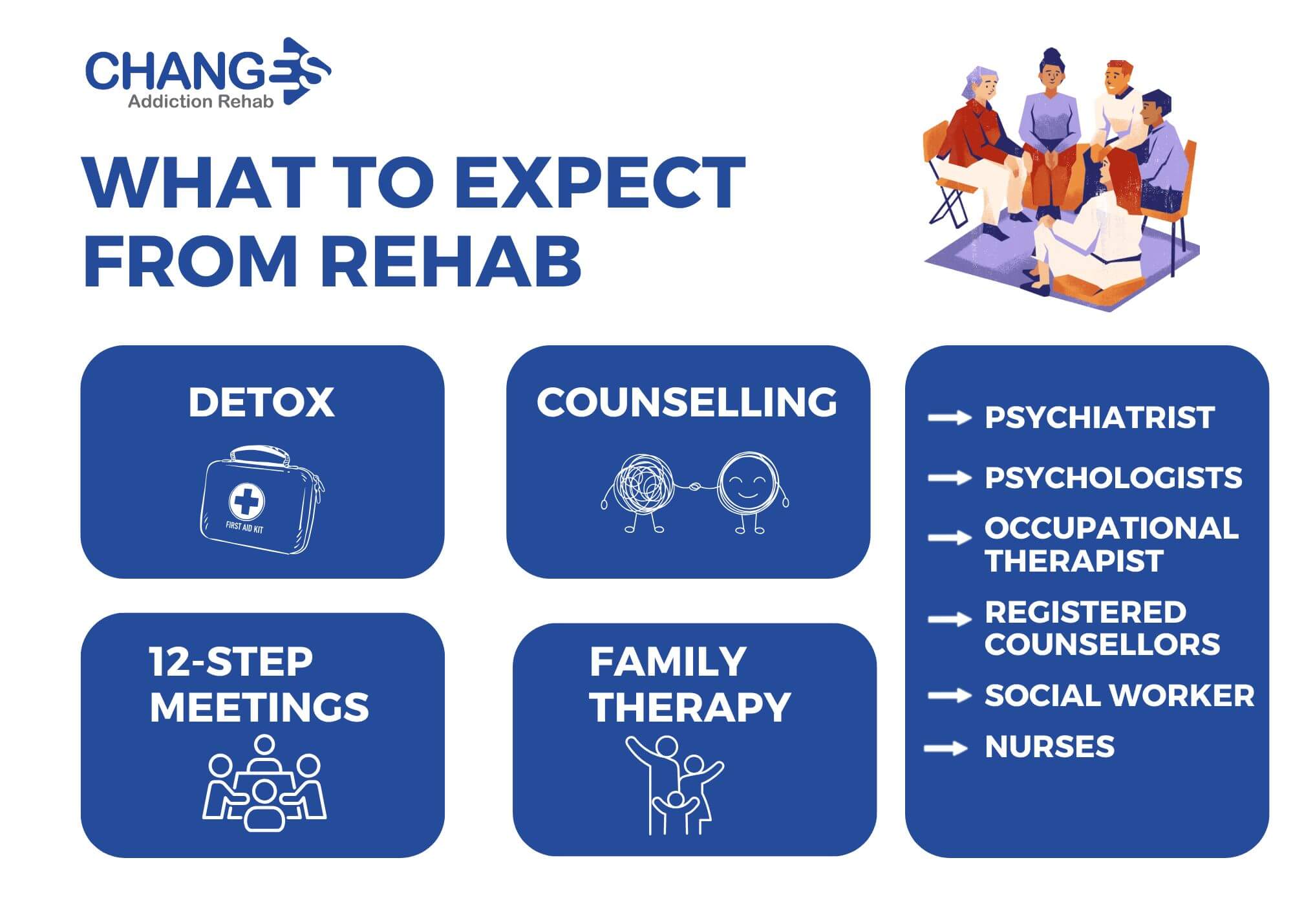Inpatient Addiction Rehab Treatment:
- Takes place in non-hospital, licensed rehabilitation centres. While approaches vary, rehabs offer detox services with 24-hour medical care in a recovery environment.
- Is intensive and is designed to treat serious substance use disorders and alcohol use disorders.
- Provide comprehensive treatment programmes designed to equip patients with the means to achieve lasting recovery.
- Duration of 30 to 90 days, depending on the severity of the addiction and individual needs.
- Patients live full-time at the rehab centre and receive physical, mental, and emotional treatment via various therapies and a structured routine.
- Residential treatment is often indicated for addicted patients who have a dual diagnosis (co-occurring mental health disorder).
Overview of Residential Inpatient Treatment for Substance Abuse Therapies
According to the Substance Abuse and Mental Health Services Administration (SAMHSA), approximately 2.35 million people received treatment for substance use disorder in 2019. Of those, 1.2 million received residential treatment services. This indicates that a significant number of individuals are receiving the help they need to overcome their addiction and make lasting changes in their lives.
 Inpatient rehab centres typically use a combination of evidence-based practices such as CBT (cognitive-behavioural therapy), MET (motivational enhancement therapy), BWRT (brain-working recursive therapy – which a great for trauma), individual psychotherapy, and group therapy.
Inpatient rehab centres typically use a combination of evidence-based practices such as CBT (cognitive-behavioural therapy), MET (motivational enhancement therapy), BWRT (brain-working recursive therapy – which a great for trauma), individual psychotherapy, and group therapy.
Patients find immense value in being of service to each other. This skill is taught and honed in group therapy. This peer support is a good learning curve setting them up to partake in the amazing 12-step recovery fellowships. We know that TSF (Twelve Step Facilitation) shows positive outcomes over the longer term for people who are addicted to alcohol or other drugs.
Some inpatient rehabs offer yoga, art therapy, mindfulness & meditation, journaling, and other holistic approaches. This approach can help individuals gain insight into their addiction and develop coping skills to deal with triggers and cravings.
Treatment also includes family therapy sessions. These family conjoints are used to reduce the patient’s denial, help loved ones understand addiction and learn how to best support their loved one during and after treatment. If the addicted person’s loved ones continue to enable the addiction and not hold the patients accountable for their recovery, treatment outcomes are reduced. Families need to learn about how addiction is a brain disease, the 3 C’s of addiction and how they can help of hinder recovery.
Causes & Risk Factors for Substance Abuse Disorder
| Risk Factor | Description |
|---|---|
| Genetic predisposition | A family history of addiction or risk genes like ADHD. |
| Absence of familial involvement | Addiction risk factors include challenging familial circumstances, a lack of attachment to parents or siblings, and inadequate parental supervision. |
| Early exposure to drugs/alcohol during teen years | This can be an important factor in the development of a substance use disorder. Research has found that teens who start drinking or using drugs at a young age are more likely to become addicted than those who wait until they are adults. This is especially true for those who start using heavily before age 18. Additionally, research suggests that early use of substances can lead to changes in the brain that increase the risk for addiction later in life. |
| Using substances to cope with stress, or numb emotions | Using substances to cope with stress or numb emotions can be a sign of an underlying mental health condition, such as depression or anxiety. Individuals may turn to drugs or alcohol in order to temporarily relieve the symptoms associated with these disorders, but this can quickly lead to addiction and further emotional distress over time. Situational triggers may also contribute to substance abuse, such as a difficult life event or exposure to peer pressure or other drugs. Additionally, individuals may have a genetic predisposition for addiction due to family history. |
| Environmental factors | Environmental factors such as the influence of peers, partners, or family members who abuse substances can also be a factor in someone developing a substance use disorder. An individual may begin abusing drugs or alcohol to fit in with their peers or due to pressure from a partner or family member who uses substances. People in this situation may not be aware that they are at an increased risk for addiction and could benefit from professional treatment. Residential inpatient treatment programs provide a safe and supportive environment where individuals can work on recovery and create healthy habits that will help them abstain from substances in the future. |
| Taking a drug that is highly addictive | Substances like amphetamine, cocaine, or opiate medicines may cause addiction to develop more quickly than other drugs. Addiction risk is increased by the method of delivery – i.e. drug injection or smoking. |
| Using “light drugs” | Using drugs that are regarded as less addictive—also referred to as “light drugs”—can lead to drug abuse and addiction. |
Components of Residential Inpatient Treatment
- Detoxification under medical supervision to clear drugs from the system
- Individual counselling & group therapy sessions – CBT, motivational interviewing, etc.
- 12-step programs like AA or NA to build a community support system
- Life skills & coping mechanisms to avoid relapse triggers
- Family counselling sessions
- Aftercare planning for continued recovery post-treatment – outpatient counselling, sober housing, support groups
Benefits Of Residential Inpatient Treatment For Substance Abuse
- The most effective way to treat substance use disorders is through comprehensive, evidence-based treatment. This includes a combination of individual counselling, group therapy, cognitive-behavioural therapy (CBT), and medication management. In addition to these traditional treatments, holistic approaches such as yoga, art therapy, and mindfulness meditation can also be beneficial in treating addiction.
- One of the key components of successful treatment is engaging in a supportive and safe environment, often in the form of a residential inpatient treatment facility. This type of program removes the individual from their everyday life and allows them to focus solely on recovery. Residential inpatient facilities provide 24-hour medical care, as well as access to therapists, psychiatrists, psychologists, and addiction specialists who can provide evidence-based treatment methods.
- Additionally, these programs also offer access to recreational activities and peer support groups that are essential for maintaining long-term sobriety.
- Residential Inpatient Treatment for Substance Abuse: For individuals with substance use disorders, residential inpatient treatment is often the best option for achieving lasting sobriety. Residential inpatient treatment provides 24-hour care, including medical and mental health services, and a safe environment free of drugs and alcohol.
- During residential inpatient treatment, individuals receive comprehensive care from a multidisciplinary team of professionals who specialize in treating substance use disorders. This can include individual and group therapy, medication-assisted treatment, relapse prevention planning, family therapy, nutrition counselling, and recreational activities. Residential inpatient treatment also allows individuals to focus on their recovery without the distractions of everyday life.
- Additionally, it provides access to support groups and other resources needed to help individuals maintain their sobriety. Aftercare services, such as sober living homes and outpatient treatment programs, are also available to help individuals transition back into their communities and stay on the path to recovery.
- Residential Inpatient Treatment for Substance Abuse: Residential inpatient treatment is the most intensive level of care available for individuals struggling with substance abuse. It involves 24-hour monitoring and access to medical professionals who can provide medication management, psychological support, and other forms of treatment.
- Residential inpatient treatment is typically a short-term solution that lasts for one to three months, depending on the severity of the substance use disorder. During this time, individuals will live in a structured environment and participate in evidence-based therapies to help them become sober and learn how to cope with the triggers of addiction.
- Removes individual from substance-abusing environment through immersion
- A 24/7 structured schedule provides consistency
- Onsite medical care available for co-occurring physical/mental health disorders
- Higher completion rates and lower risk of relapse during treatment
- The development of a new peer community reinforces sobriety
Criticisms of Residential Inpatient Treatment
- High cost can be prohibitive – private programs can cost tens of thousands per month
- Disrupts home/work life – requires taking significant time off
- Potential dependency on treatment setting versus real-world environment
- Low external motivation once back in old environment
- Relapse still possible once back home around previous cues/triggers
It must be said though that for severe addictions there is often no other way. Inpatient residential treatment allows the patient to structure their life around recovery and not active addiction. This total 180-degree shift is what is required in these cases. We have to understand severe addiction as a primary illness. Without treating the addiction first and getting the patient into long-term stable recovery, nothing else can be addressed. all other areas of their lives continue to deteriorate.
Their ability to function at home, work, and socially doesn’t improve. Their mental health keeps getting worse. We have to focus on the addiction as the first issue. Once this is achieved, every other aspect of their life improves in and of itself and the other areas that need more attention can be more clearly seem and addressed.
Trends & New Approaches to Inpatient Rehab
- More holistic programs with yoga, meditation, equine therapy, art, etc.
- Increased use of medications like buprenorphine to treat opioid addiction
- Dual diagnosis treatment for co-occurring disorders
- Gender/age-specific programs to target needs
- Mobile apps and tech tools to support ongoing recovery
- Focus on building transitional living & vocational skills
Conclusion
- Overall effectiveness for those with severe addictions
- Importance of continued research on new treatment approaches
- More accessible and affordable options would expand access
- Community-based support system vital for maintaining long-term recovery




